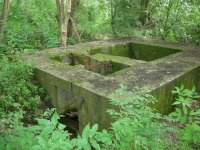I'm still behind with posting pics from our visits of the forts of the "Hollandse Waterlinie". Blogger wasn't helpful because the server was slow for some unknown reason, which caused very long uploadtimes for the pics I wanted to post. Sometimes more than 4 to 5 minutes per picture. When you are running a photoblog it doesn't require much math to figure out how much time it cost to post 12 pictures, so I decided to wait until the server was a bit quicker.
Anyway the pictures from my former post about Fort Hinderdam (only Dutch) were taken on September 2nd in the morning. The pictures I'm about to post now were taken on the same day in the afternoon at Fort Lunetten which contains four defenseworks. Lunetten is also the name of the district or neighbourhood of my hometown Utrecht. We visited Lunet I and III. The English word for this type of defense work is lunette, a half moon shaped fortification. Number II and IV are in use by Dutch Scouting and numbers I and III were open for public that day. Until our visit I didn't know that the name of the neighbourhood was referring to this type of fortifications.
We had two interesting guided tours. Although most of the forts lost their military function after World War II, some of them have been used until the late seventies. The interesting thing about Lunet I was that there was also an atomic bombfree bunker, built in 1965 that functioned as a major communication centre during the Cold War until 1980. Picture 9 and 10 were taken at the atomic bunker. Hopefully the pictures give you a bit of an impression.
Anyway the pictures from my former post about Fort Hinderdam (only Dutch) were taken on September 2nd in the morning. The pictures I'm about to post now were taken on the same day in the afternoon at Fort Lunetten which contains four defenseworks. Lunetten is also the name of the district or neighbourhood of my hometown Utrecht. We visited Lunet I and III. The English word for this type of defense work is lunette, a half moon shaped fortification. Number II and IV are in use by Dutch Scouting and numbers I and III were open for public that day. Until our visit I didn't know that the name of the neighbourhood was referring to this type of fortifications.
We had two interesting guided tours. Although most of the forts lost their military function after World War II, some of them have been used until the late seventies. The interesting thing about Lunet I was that there was also an atomic bombfree bunker, built in 1965 that functioned as a major communication centre during the Cold War until 1980. Picture 9 and 10 were taken at the atomic bunker. Hopefully the pictures give you a bit of an impression.












No comments:
Post a Comment